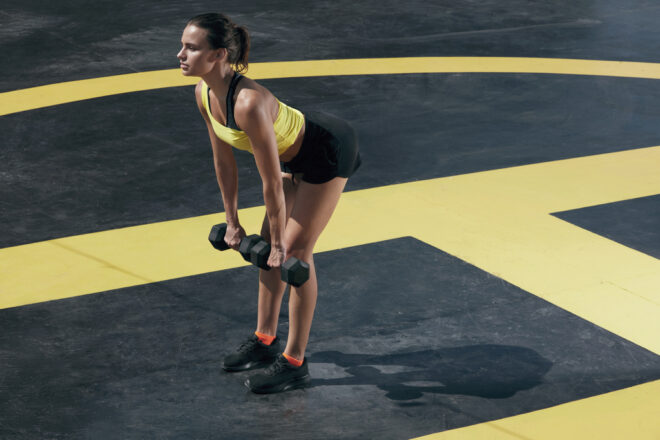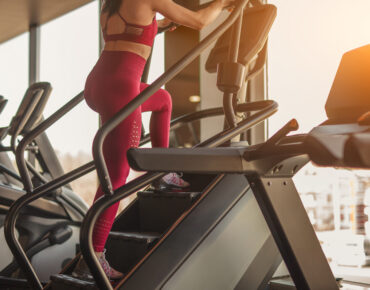At home or at the gym, the dumbbell deadlift is a challenging and rewarding full-body exercise.
You can do it several times a week to work your back and improve your lower body and core strength. And since it activates some of the key running muscles, it’s a great exercise for runners.
Read on to find out what muscles dumbbell deadlifts work and how to do them properly.
In This Article:
What Are Dumbbell Deadlifts?
The dumbbell deadlift is a compound exercise that helps you build strength in your lower body, back, and shoulders while also engaging your core.
A high-intensity exercise, it can provide a full-body workout while encouraging a wide range of motion that’s healthy for your joints.
Dumbbell deadlifts are a safe and effective alternative to a gym favorite – barbell deadlifts. A 2021 study on college football players found that dumbbell and barbell repetitions with a similar weight placed a similar demand on the upper body.
Dumbbell deadlifts are a demanding but beginner-friendly exercise. Proper deadlift form is crucial to reap the benefits of the exercise. But with a bit of practice, it’s easy to get right.
You can easily adapt the exercise to your fitness level by increasing or decreasing the weights. Since dumbbells take up less space than barbells, you can also do the exercise at home.
Benefits of the Dumbbell Deadlift
Doing the dumbbell deadlift exercise regularly enables you to build muscle, fix muscle imbalances, strengthen your grip, and improve balance, posture, and mobility. Let’s take a closer look at these benefits.
Builds muscle mass
With the dumbbell deadlift, you put leg muscles, lats, core, and lower back muscles through high stress, followed by mechanical tension.
The exercise exerts more muscle tension on the muscles it works than a conventional deadlift, hence bigger muscle gains.
Addresses muscle imbalances
Noticing a muscle imbalance in your leg muscles? The dumbbell deadlift can help you correct it, especially if you integrate weightlifting into your training routine.
With this exercise, both sides of your body sustain equal tension. Compared to other dumbbell exercises, you don’t run the risk of working one side more than the other.
Strengthens your grip
Another major benefit of this exercise is a stronger grip. The dumbbell deadlift places more stress on your grip than barbell deadlifts because you’re doing more repetitions.
More than making weight exercises and everyday actions easier, a strong grip is associated with better health in older adults.
Improves balance and mobility at any age
Research indicates that deadlifts improve balance and mobility. They also contribute to your overall fitness level.
Increases the range of motion
Dumbbells promote a wider range of motion than weight plates. Studies indicate that training performed with a full range of motion enhances the building of muscle mass in the lower body.
Improves stability and posture
Dumbbell deadlifts activate your core and stabilizer muscles, which helps with lifting weights in the gym and during everyday movements.
Just think of the last time you had to balance heavy shopping bags on your way home from the grocery store. This exercise can make that kind of weight balancing easier.
And since it works the traps and erector spinae muscles, the deadlift can help prevent slouching and stabilize your spine, resulting in an overall better posture.
A 2013 study found that an 8-week balance training program can improve balance and flexibility in weight lifters. It may also boost overall sports performance.
Muscles Worked by Dumbbell Deadlifts
So, what does a dumbbell deadlift work? The dumbbell deadlift works the quads, glutes, hamstrings, core, traps, lats, and lower back muscles.
It works primarily the following muscles:
- Quads. Located at the front of the thigh, the quadriceps make walking, running, or jumping possible.
- Glutes. The three gluteal muscles make up the buttocks. Together, these muscles push your body forward as you walk and help keep you upright.
- Hamstrings. The hamstrings at the back of the thigh enable walking, squatting, climbing stairs, and most other lower-body movements.
- Lats. The V-shaped muscles connecting your arms to the spine, the lats stabilize your spine. They also help support posture and enable shoulder and arm movement.
- Traps. These muscles extend from the mid-back to the neck, helping to make your back stronger.
The dumbbell deadlift also engages:
- Core muscles. The core comprises four interconnected muscles, including the transversus abdominis, diaphragm, multifidus, and pelvic floor. These muscles help balance the load on the spine and transfer force between the upper and lower body.
- Erector spinae. Running along the spine, this muscle helps stabilize the spinal column.
How to Do Dumbbell Deadlifts
Before you do the exercise, it’s important to warm up. A warm-up reduces the risk of injury and gears you up for the coming reps. What’s more, a warm-up can improve your balance and stability during dumbbell deadlifts, a pilot study indicates.
Start with a light, low-intensity cardiovascular training warm-up for 5–15 minutes. During the warm-up, try to break a sweat. You can also try foam rolling for your thigh, hamstring, glutes, and back. Then add some dynamic stretches, and you’re good to go.
Important: Practice the movement without any weights to make sure you get the deadlift form right. Then choose a weight you can handle for 2 sets of at least 6 reps each.
1. Pick a dumbbell in each hand with an overhand grip.
2. Hold the weights in front of your sides.
3. Stand with your feet under your shoulders and knees slightly bent.
4. Bend your hips and knees and lower your torso while allowing your arms to hang down in front of your lower legs.
5. Continue to lower yourself with a controlled movement while keeping your back neutral until your torso is almost parallel with the floor.
6. Squeezing your glutes, return slowly to the starting position by pushing through the ball and heel of your foot to complete a repetition.
7. Do 2–3 sets of 6–12 reps each, depending on your fitness level.
Dumbbell Deadlift Variations
Once you become used to the traditional dumbbell deadlift, you can spice up your dumbbell workouts with a few variations of the exercise.
Staggered deadlift
During this variation, your back foot remains on the ground behind you. Try this variation before advancing to the single-leg deadlift.
1. Stand with your feet together, holding the weights in front of your thighs.
2. Step back with your right foot about 10 inches.
3. With your left knee slightly bent, hinge forward at the hips to perform the deadlift.
4. Lower the dumbbells until your body is almost parallel to the floor.
5. Bracing your core, push through your left foot to bring yourself back up.
6. Do all reps on one side, then switch to the other.
Single-leg deadlifts
This dumbbell deadlift variation requires more core strength than the standard exercise. It can improve balance and stability and help address muscle imbalances.
1. Get into the starting position by standing with your feet under your hips and a dumbbell by your left side at arm’s length. Then shift your weight to your right foot and lift your left foot behind you a few inches off the floor.
2. Push your hips back, hinge, and lower the weight even as you raise your left leg behind you. Keep your right leg slightly bent and your core engaged.
3. Pause at the end of the movement and return to the standing position by lowering your left leg.
4. Do reps on one side first and then on the other.
Dumbbell Romanian deadlift
During this variation, the dumbbells won’t be touching the floor. The exercise improves hip mobility.
1. Start with your feet under your shoulders and the dumbbells hanging in front of you.
2. Lower the weights, maintaining the slight bend in your knees until you feel the stretch in the back of your legs.
3. Once you feel the stretch, bring yourself up, pushing the hips forward and squeezing your glutes.
Dumbbell stiff leg deadlift
Targeting mostly the hamstrings, this exercise calls for a lighter weight. The hamstrings are weaker than other muscles and easily engaged. The movement pattern is easier than the standard exercise.
1. Stand holding a dumbbell in each hand in front of your thighs.
2. Bend your knees slightly.
3. Hinge at the waist and push your hips back while keeping your back flat and core braced.
4. Continue the movement until your torso is almost parallel to the ground and you feel the stretch in your hamstrings.
5. Pause and slowly return to the starting position.
Sumo deadlift
As the name implies, this variation uses a very wide stance. It’s easier on your back than conventional exercise.
1. Stand with feet further than your shoulder width and toes outward.
2. Hinging at the hips, lower the dumbbells between your feet while keeping your back flat.
3. Pause for a moment and slowly return to the initial position to complete a rep.
Dumbbell squat
While not technically a deadlift variation, the dumbbell squat is worth mentioning. The difference is that this exercise starts with a negative rep followed by a positive one. This allows you to handle more weight.
1. Stand with feet slightly wider than shoulder-width apart and dumbbells at the sides.
2. Lower yourself into a squat while keeping your back straight.
3. Once your thighs are parallel to the floor, bring yourself up to complete a rep.
Tips to Do Dumbbell Deadlifts Properly
So, how to do dumbbell deadlifts with proper form? It’s not hard. Follow the next tips to get the deadlift form right and avoid injury.
- On the way down, hold your hands close to your shins to prevent back strain. This ensures your legs and glutes bear most of the weight.
- Keep your head up and your eyes looking ahead. Don’t start the deadlift looking down, or you may break form.
- Don’t allow your back to become rounded. Keep it straight.
- Don’t pull the dumbbells from the floor as you come up. Instead, focus on the standing-up movement.
- Once the dumbbells rise to your knees, push your hips forward and bring your shoulder blades back.
- Don’t start with the hips too high or too low, or you’ll strain your back or lose power.
- When you progress to heavy weights, use lifting straps for an adequate grip without damaging your wrists.
- Don’t start with heavy weights. Learn the movement with manageable weights before increasing the load.
Practice makes dumbbell deadlifts perfect. In the beginning, focus on form. If you get the form right, you’ll maximize the benefits of the exercise without straining your back or risking injury.
Takeaways
Before you try the dumbbell deadlift and its variations, here are the things to remember:
- The dumbbell deadlift uses a wider range of motion than the barbell deadlift.
- You can use this exercise to build muscle mass in the upper legs, back, and core.
- Getting the form right is crucial to avoid back strain and other injuries, so don’t rush the exercise.
- Start with manageable weights and increase the load progressively.
- Always warm up before your weightlifting workout.
In the end, remember that this is a full-body workout with dumbbells. Give yourself enough rest time to avoid injury.
References:
- Piper, T.J. and Waller, M.A., 2001. Variations of the deadlift. Strength & Conditioning Journal, 23(3), p.66.
- Kompf, J.M., Rhodes, R.E. and Lee, S., 2022. Selecting Resistance Training Exercises for Novices: A Delphi Study with Expert Consensus. American Journal of Lifestyle Medicine, p.15598276221115662.
- Bird, S. and Barrington-Higgs, B., 2010. Exploring the deadlift. Strength & Conditioning Journal, 32(2), pp.46-51.
- Chang, K.H., Chen, M.Y. and Canny, J., 2007, September. Tracking free-weight exercises. In International Conference on Ubiquitous Computing (pp. 19-37). Berlin, Heidelberg: Springer Berlin Heidelberg.
- Weakley, J.J., Till, K., Read, D.B., Roe, G.A., Darrall-Jones, J., Phibbs, P.J. and Jones, B., 2017. The effects of traditional, superset, and tri-set resistance training structures on perceived intensity and physiological responses. European journal of applied physiology, 117, pp.1877-1889.














